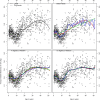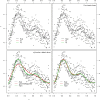A review of spline function procedures in R
- PMID: 30841848
- PMCID: PMC6402144
- DOI: 10.1186/s12874-019-0666-3
A review of spline function procedures in R
Abstract
Background: With progress on both the theoretical and the computational fronts the use of spline modelling has become an established tool in statistical regression analysis. An important issue in spline modelling is the availability of user friendly, well documented software packages. Following the idea of the STRengthening Analytical Thinking for Observational Studies initiative to provide users with guidance documents on the application of statistical methods in observational research, the aim of this article is to provide an overview of the most widely used spline-based techniques and their implementation in R.
Methods: In this work, we focus on the R Language for Statistical Computing which has become a hugely popular statistics software. We identified a set of packages that include functions for spline modelling within a regression framework. Using simulated and real data we provide an introduction to spline modelling and an overview of the most popular spline functions.
Results: We present a series of simple scenarios of univariate data, where different basis functions are used to identify the correct functional form of an independent variable. Even in simple data, using routines from different packages would lead to different results.
Conclusions: This work illustrate challenges that an analyst faces when working with data. Most differences can be attributed to the choice of hyper-parameters rather than the basis used. In fact an experienced user will know how to obtain a reasonable outcome, regardless of the type of spline used. However, many analysts do not have sufficient knowledge to use these powerful tools adequately and will need more guidance.
Keywords: Functional form of continuous covariates; Multivariable modelling.
Conflict of interest statement
Ethics approval and consent to participate
Not applicable.
Consent for publication
Not applicable.
Competing interests
The authors declare that they have no competing interests.
Publisher’s Note
Springer Nature remains neutral with regard to jurisdictional claims in published maps and institutional affiliations.
Figures






References
-
- Chambers JM, Hastie TJ. Statistical methods in S. Pacific Grove: Wadsworth & Brooks/Cole Advanced Books & Software; 1992.
-
- De Boor C. A practical guide to splines. New York: Springer-Verlag; 2001.
-
- de Vries A. On the Growth of Cran Packages, r bloggers. 2016. https://www.r-bloggers.com/on-the-growth-of-cran-packages.
Publication types
MeSH terms
LinkOut - more resources
Full Text Sources
Other Literature Sources

